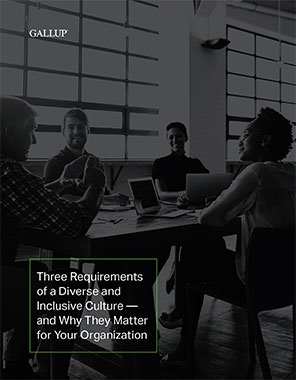Story Highlights
- Inclusivity is a key feature of a strengths-based organizational culture
- Performance improves when employees focus on their strengths
- A successful DEI strategy requires long-term commitment
In an era of renewed commitment to diversity, equity and inclusion, many leaders continue to search for answers -- proven ways to promote DEI.
One crucial lever is work culture, or "how we do things around here." Culture is central to the "I" in DEI -- making employees feel welcome and like they belong. Employees' day-to-day experiences in your culture are where the rubber meets the road in your inclusion efforts -- where you can prove your commitment to DEI by creating an inclusive employee experience.
As part of a holistic DEI strategy, focusing on employees' strengths is a winning strategy for building an inclusive work culture. "Inclusion" is about feeling seen and appreciated for who you are -- your unique contributions. When leaders make it a priority to understand, value and cultivate each individual's strengths, they convey genuine respect and appreciation for what makes each employee one of a kind.
In fact, one Gallup study showed that teams with a higher proportion of individuals who gained awareness of their strengths realized a substantially higher improvement in perceived inclusiveness.
The CliftonStrengths assessment reveals people's natural inclinations -- what they do exceptionally well. As a result, CliftonStrengths is an invaluable tool for creating a strengths-based work culture that supports DEI goals.
Three Ways CliftonStrengths Supports Inclusion
1. Strengths Is About Celebrating Individuals
In an inclusive workplace, employees are recognized for their unique personalities, beliefs and abilities. Because CliftonStrengths lends perspective, it helps employees understand and embrace one another's motivations, needs, feelings, behavioral tendencies, thought processes and more.
CliftonStrengths also creates self-awareness: It helps employees recognize what doesn't come easily to them and where they may have blind spots with others -- including how they observe, evaluate and address their colleagues.
Ultimately, CliftonStrengths is about valuing everyone's authentic selves -- and appreciating both similarities and differences. It helps employees own "who they are" in a way that promotes mutual acceptance.
2. Strengths Provides a Common Language
When teams have CliftonStrengths as a shared language, difficult conversations and conflict resolution are easier to navigate. A positive, common terminology can serve as a bridge for cultural and demographic differences. And through talking about their top strengths, a diverse group of people can discuss not only shared interests but also how their differences can produce complementary partnerships.
When teams can talk about their strengths, they can break down stereotypes and replace them with belongingness, collaboration and understanding. Asking someone about their CliftonStrengths is an easy way to start a conversation about important topics, from how people approach tasks to communication preferences.
Plus, when people feel like they belong, they're more comfortable sharing opinions, ideas and critiques. This feedback can illuminate shortcuts to a more diverse and welcoming workplace.
Employees' day-to-day experiences in your culture are where the rubber meets the road in your inclusion efforts.
3. Strengths Helps Leaders Operationalize Their DEI Strategy
To achieve DEI goals, leaders need a structured approach and accountability -- which is why more leaders are appointing chief diversity officers, creating diversity task forces, and clearly outlining responsibilities and expectations for DEI goals.
A powerful infrastructure for any inclusion initiative is a strengths-based culture. The best practices that create a strengths-based culture necessarily support an environment of acceptance -- that is, an inclusive culture.
For example, one best practice for developing a strengths-based culture is holding managers accountable for facilitating ongoing, strengths-based performance conversations. These conversations provide a framework to help managers celebrate what every individual brings to the table.
Through decades of research, Gallup has discovered proven ways to create a strengths-based work culture. Here are five actions to help leaders get started:
- Start with the CEO or executive sponsor. For strengths to become part of the culture, leaders must prioritize strengths as a long-term business strategy -- and consistently communicate their commitment to strengths development.
- Give every employee the opportunity to discover their strengths. Best-in-class workplaces use CliftonStrengths to discover employees' natural gifts and start having conversations about strengths that promote inclusion.
- Build an internal network of strengths coaches and champions. Internal strengths champions are conduits for growth who teach teams about strengths, provide practical support and instill passion for the movement.
- Integrate strengths into performance management. With strengths, managers can provide personalized recognition and performance feedback -- and ultimately, coach each individual to improve and grow.
- Transform your internal programs. Leaders need to assess existing programs and practices -- from messaging to the phases of the employee life cycle -- to ensure they support strengths goals.
Here's another important takeaway: Before leaders can start changing their culture, they need to assess their current culture, define their ideal state and then bridge the gap between the two. This is why Gallup's approach to culture transformation starts with an in-depth audit of the current culture.
When leaders make strengths part of their culture, they communicate to employees, "You belong. You matter. You're invaluable -- just as you are."
The Performance Benefits of a Strengths-Based Culture
A strengths-based work culture does far more than encourage inclusion: It fuels performance. Employees in a strengths-based work culture are more engaged, innovative and agile. They're also much likelier to feel like their personal development is supported and that someone at work cares about them. Ultimately, focusing on strengths deepens employees' commitment to their workplace.
There's no "quick fix" when it comes to DEI: Leaders must be committed to a lifetime of learning and action. For many leaders, CliftonStrengths is an invaluable aspect of a larger DEI plan because it's a scientifically proven way to increase perceived inclusiveness.
When leaders make strengths part of their culture, they communicate to employees, "You belong. You matter. You're invaluable -- just as you are."
Create an organizational culture where people feel like they belong:
- Learn about creating a strengths-based company culture.
- Read more about why an inclusive culture matters.
- Discover how the CliftonStrengths assessment can transform your organization.




